
Austromuellera is a genus of only two known species of medium-sized trees, constituting part of the plant family Proteaceae. They are both endemic to three restricted areas of the wet tropics rainforests of north-eastern Queensland, Australia. The genus was named in 1930 in honour of Ferdinand von Mueller by Cyril T. White. They lie within the tribe Banksieae within the family Proteaceae, their closest relatives the genera Musgravea and Banksia.

Musgravea is a genus of rainforest tree from north-eastern Queensland.
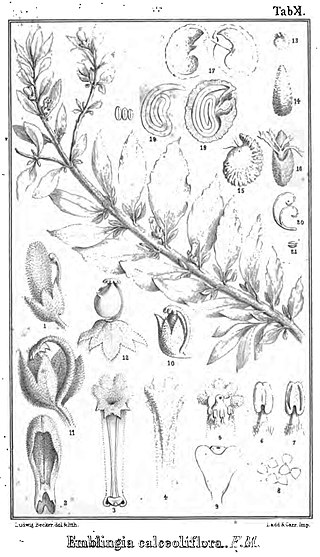
Emblingia is a monospecific plant genus containing the species Emblingia calceoliflora, a herbaceous prostrate subshrub endemic to Western Australia. It has no close relatives, and is now generally placed alone in family Emblingiaceae.
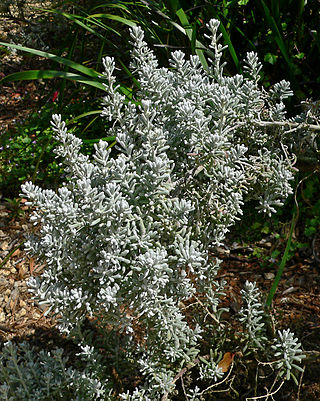
Maireana is a genus of around 57 species of perennial shrubs and herbs in the family Amaranthaceae which are endemic to Australia. Species in this genus were formerly classified within the genus Kochia. The genus was described in 1840 by the botanist, Moquin-Tandon and named to honour Joseph François Maire (1780-1867), an amateur botanist who befriended him during the author's first visit to Paris in 1834.

Stirlingia simplex is a plant endemic to Western Australia.
Atriplex bunburyana, commonly known as silver saltbush, is a species of saltbush endemic to Western Australia.
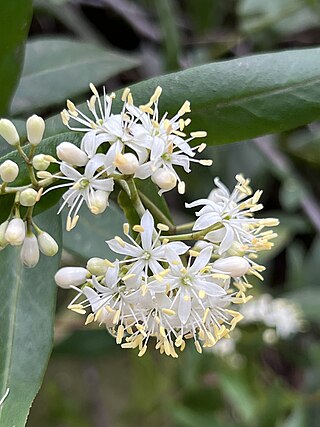
Leionema ambiens is a rare shrub growing in the Guyra district of New South Wales and Queensland, Australia. It has long stem clasping leaves and heads of white flowers in spring and early summer.
Trochocarpa clarkei, commonly known as lilac berry, is a rare flowering plant in the family Ericaceae. It is endemic to sub-alpine areas of Victoria in Australia. It is a shrub which grows to around 30 cm high. The flowers are maroon with a greenish base. The fruits, which appear in autumn, are about 8 mm in diameter. These are eaten by small mammals and birds. The species occurs in subalpine areas of the southern highlands, often in association with Eucalyptus pauciflora.
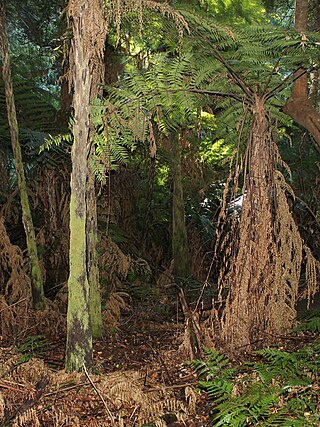
Alsophila leichhardtiana, synonym Cyathea leichhardtiana, the prickly tree fern, is a plant in the tree fern family, Cyatheaceae, found in eastern Australia. It is a common species found in moist situations, in and near rainforests. It was named in honour of the explorer and botanical collector Ludwig Leichhardt.
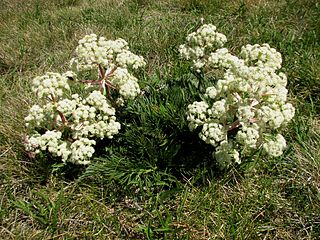
Aciphylla glacialis, commonly known as snow aciphyll or mountain celery, is a tufted perennial plant that is found in mountainous regions of south-eastern Australia. The species was first formally described in 1855 by Victorian Government Botanist Ferdinand von Mueller as Gingidium glaciale. In 1867 the species was transferred to the genus Aciphylla and given its current name by English botanist George Bentham in Flora Australiensis. It occurs in Victoria and New South Wales.

Pachymitus is a monotypic plant genus in the mustard family Brassicaceae. The sole species is Pachymitus cardaminoides, commonly known as sand cress, which is native to Australia. It occurs in the states of New South Wales, Victoria and South Australia.
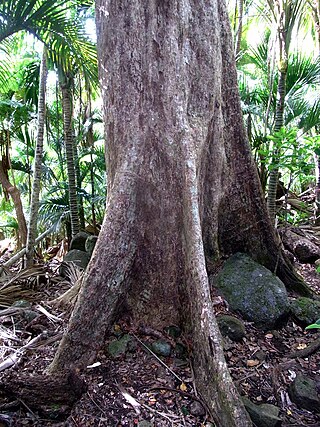
Syzygium fullagarii, commonly known as the scalybark, is a relatively large tree in the family Myrtaceae. It is found only on Lord Howe Island. It grows to 20 metres tall, up to an altitude of 400 metres above sea level in sheltered areas, often in rainforest. The bark is reddish brown, usually flaking to the touch. The base of the tree is often heavily buttressed. Known for many years as Cleistocalyx fullagarii, however, in recent times it has been placed in the large genus Syzygium.

Maireana pyramidata is a species of plant within the genus, Maireana, in the family Amaranthaceae. It is endemic to Australia, and widespread throughout Australia in the inland, where it is found in Victoria, New South Wales, Queensland, the Northern Territory and Western Australia.

Ptilotus pyramidatus, the pyramid mulla mulla, is a small white herb in the family Amaranthaceae.
Asteridea croniniana is a herb in the Asteraceae family, which is endemic to Western Australia. It is an annual herb, growing to a height of 8 cm.

Rhodanthe battii is a species of flowering plant in the family Asteraceae, native to Western Australia.

Maireana trichoptera is a plant in the Amaranthaceae family, native to all mainland states and territories of Australia except Queensland.

Maireana thesioides is a plant in the Amaranthaceae family, native to Western Australia.

Sclerolaena eurotioides is a species of flowering plant in the family Amaranthaceae, native to Western Australia. It was first described in 1869 by Ferdinand von Mueller as Echinopsilon eurotioides, but was transferred to the genus, Sclerolaena in 1978 by Andrew John Scott.
Maireana cheelii, common name - chariot wheels, is a species of flowering plant in the family Amaranthaceae, native to Victoria, New South Wales, and Queensland. It is found on seasonally wet, heavy loams and clay soils.















